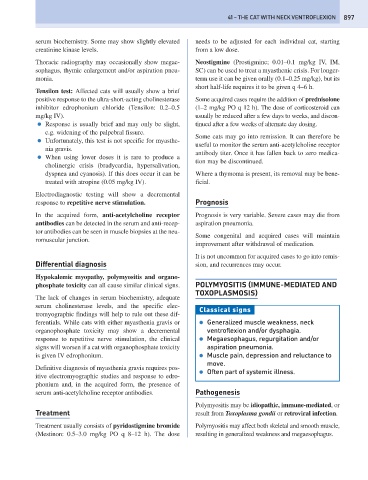Page 905 - Problem-Based Feline Medicine
P. 905
41 – THE CAT WITH NECK VENTROFLEXION 897
serum biochemistry. Some may show slightly elevated needs to be adjusted for each individual cat, starting
creatinine kinase levels. from a low dose.
Thoracic radiography may occasionally show megae- Neostigmine (Prostigmine; 0.01–0.1 mg/kg IV, IM,
sophagus, thymic enlargement and/or aspiration pneu- SC) can be used to treat a myasthenic crisis. For longer-
monia. term use it can be given orally (0.1–0.25 mg/kg), but its
short half-life requires it to be given q 4–6 h.
Tensilon test: Affected cats will usually show a brief
positive response to the ultra-short-acting cholinesterase Some acquired cases require the addition of prednisolone
inhibitor edrophonium chloride (Tensilon: 0.2–0.5 (1–2 mg/kg PO q 12 h). The dose of corticosteroid can
mg/kg IV). usually be reduced after a few days to weeks, and discon-
● Response is usually brief and may only be slight, tinued after a few weeks of alternate day dosing.
e.g. widening of the palpebral fissure.
Some cats may go into remission. It can therefore be
● Unfortunately, this test is not specific for myasthe-
useful to monitor the serum anti-acetylcholine receptor
nia gravis.
antibody titer. Once it has fallen back to zero medica-
● When using lower doses it is rare to produce a
tion may be discontinued.
cholinergic crisis (bradycardia, hypersalivation,
dyspnea and cyanosis). If this does occur it can be Where a thymoma is present, its removal may be bene-
treated with atropine (0.05 mg/kg IV). ficial.
Electrodiagnostic testing will show a decremental
response to repetitive nerve stimulation. Prognosis
In the acquired form, anti-acetylcholine receptor Prognosis is very variable. Severe cases may die from
antibodies can be detected in the serum and anti-recep- aspiration pneumonia.
tor antibodies can be seen in muscle biopsies at the neu-
Some congenital and acquired cases will maintain
romuscular junction.
improvement after withdrawal of medication.
It is not uncommon for acquired cases to go into remis-
Differential diagnosis sion, and recurrences may occur.
Hypokalemic myopathy, polymyositis and organo-
phosphate toxicity can all cause similar clinical signs. POLYMYOSITIS (IMMUNE-MEDIATED AND
TOXOPLASMOSIS)
The lack of changes in serum biochemistry, adequate
serum cholinesterase levels, and the specific elec-
Classical signs
tromyographic findings will help to rule out these dif-
ferentials. While cats with either myasthenia gravis or ● Generalized muscle weakness, neck
organophosphate toxicity may show a decremental ventroflexion and/or dysphagia.
response to repetitive nerve stimulation, the clinical ● Megaesophagus, regurgitation and/or
signs will worsen if a cat with organophosphate toxicity aspiration pneumonia.
is given IV edrophonium. ● Muscle pain, depression and reluctance to
move.
Definitive diagnosis of myasthenia gravis requires pos-
● Often part of systemic illness.
itive electromyographic studies and response to edro-
phonium and, in the acquired form, the presence of
serum anti-acetylcholine receptor antibodies. Pathogenesis
Polymyositis may be idiopathic, immune-mediated, or
Treatment result from Toxoplasma gondii or retroviral infection.
Treatment usually consists of pyridostigmine bromide Polymyositis may affect both skeletal and smooth muscle,
(Mestinon: 0.5–3.0 mg/kg PO q 8–12 h). The dose resulting in generalized weakness and megaesophagus.

